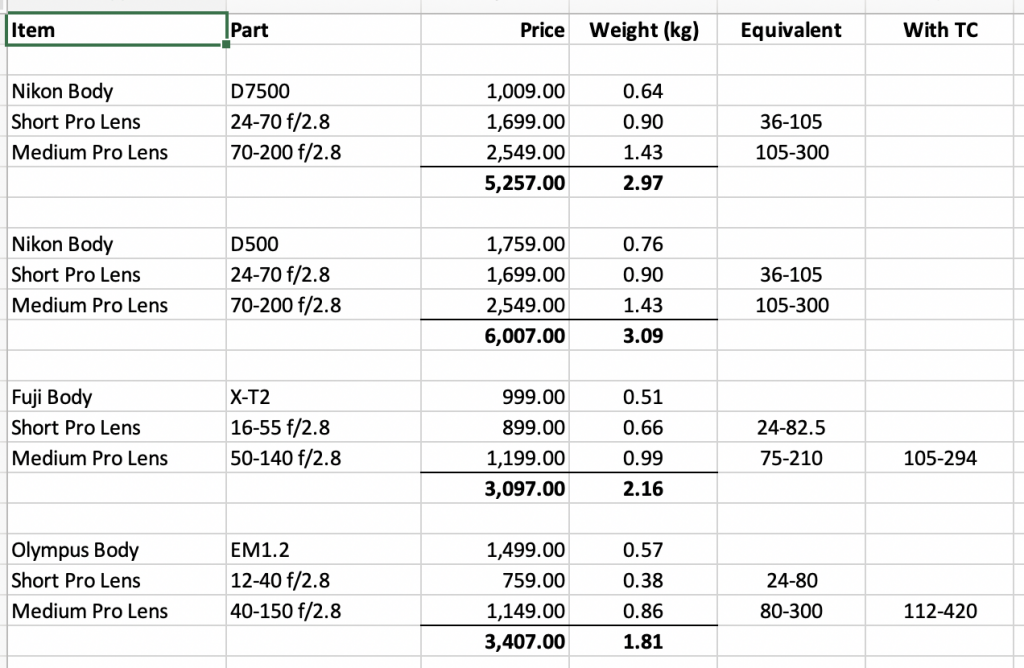With the recent “debate” online about m4/3 being dead / at risk / in decline or whatever you happen to believe, and my (very long-winded) article recently attempting to debunk certain “myths” as I see them about m4/3 in general, I thought I’d revisit my reasoning behind buying the Olympus EM1 Mk2 to see if my thoughts were still relevant. Of course, the danger here is that I rethink my decision and decide I choose wrongly, which would be unfortunate!
Anyway, bearing in mind where I started, a Nikon D3300 + some cheap DX lenses + a big Sigma 150-600mm zoom, here’s a comparison I compiled at the time to give flesh to my thoughts, and the systems I was considering as an upgrade.
My first requirement was for a better, faster, sports orientated camera body. In particular I wanted frame-rate (the D3300 was slow at 5 fps) and buffer (the D3300 was rubbish at 6-ish frames total before slowing down). I also wanted weather-sealed, and whatever other benefits might be had from a newer, better, camera, taking into account the lenses I’d need for it and the overall weight of the system. I wasn’t taking the Sigma out with me very much because it was too big and heavy, and as they say “the best camera is the one you have with you”, I identified weight as a serious factor in my decision making.
Here’s what I came up with (I do like spreadsheets):

My first thought was of course to stick to Nikon, and go for the D7500 or D500 bodies. The D7500 is 8fps, and the D500 is 10fps, and considered one of the best sports cameras of any make or format. But to go with these I’d want the 2 big f/2.8 zooms, the 24-70 and the 70-200. These lenses are expensive, and heavy, being designed for full-frame cameras rather than the APS-C sensor in the D7500 and D500. These combinations would’ve given me an effective (FF equivalent) focal length range of 36 – 300mm, and would’ve represented a fully weather-sealed semi-pro sports camera set-up, but the cost seemed prohibitive. To be fair I could’ve reduced the cost, significantly, by buying 2nd hand lenses, but would still have been a stretch, and from a weight perspective, certainly if I included the Sigma 150-600 (which I could’ve kept if I’d stayed with Nikon) I’d have been looking at carrying 5kgs of camera gear on my back, and at my age that’s not something I wanted to have to do.
Then I looked at the Fuji X system, at the time the XT2 (the XT3 has recently replaced it). This looked like a great system, and unlike most APS-C systems it has a full range of pro lenses specifically designed for the sensor size, in particular the 16-55 and 50-140 f/2.8 zooms. This would give me the same focal length range as the Nikon options (provided I included the 1.4x tele-converter for the 50-140 zoom), but cost a lot less, and, being mirrorless and APS-C specific lenses, weigh less. This was a serious contender, but I wasn’t sure 300mm(-ish) FF equivalent reach would be enough. I examined the photos I’d taken so far, with the Nikon D3300 + Sigma 150-600, and figured I’d need something approaching the 400mm mark, so Fuji was either going to leave me a bit short or I’d have to add the Fuji 100-400 f/5.6 lens, which would’ve pushed up the cost and weight considerably.
I also looked at the Olympus EM1 Mk2, with it’s pro f/2.8 zooms. This weighed even less overall, and being m4/3 gave me a bit more reach, especially with the 1.4x tele-converter, getting me out to a 400mm FF equivalent, further than the Nikon solutions and possibly negating the need for a longer zoom.
I also had concerns about some aspects of the Fuji system. I read that battery life wasn’t great, that I’d pretty much need the battery grip to ensure I could get a days shooting out of it, which was more expense, and weight, and I wasn’t sure I really liked the retro feel of the XT-2 with dedicated dials on top for shutter speed etc. To be fair however, I’ve found battery life on my EM1 Mk2 to be way, way better than reported so I’m sure the same applies to the Fuji.
At the time I purchased the Olympus EM1 Mk2 it was on offer as a bundle including both the lenses I wanted, for a total of £3,200, and it came with a £250 battery grip thrown in for free, so that made it an even more attractive proposition. And one other aspect that at the time I didn’t place much importance on but which has proven its weight in gold, is IBIS (In Body Image Stabilisation). The Olympus EM1 Mk2 has it, the others don’t, and I’d never found OIS (Optical Image Stabilisation), which Nikon calls VR (Vibration Reduction), to be worth much. But Olympus’s IBIS is a thing of wonder, I can take hand-held shots (of static subjects) at insanely low shutter speeds (like a second or 2, as in whole seconds, not fractions of a second).
So all in all I have a hugely capable sports camera that’s small and light enough to act as a general purpose travel camera, thanks to IBIS I can shoot indoors without flash and still get sharp photos, it’s perfectly balanced for me, even, and especially, with the 40-150mm f/2.8 PRO lens, and takes stunning photos that I’d never imagined I’d be capable of.